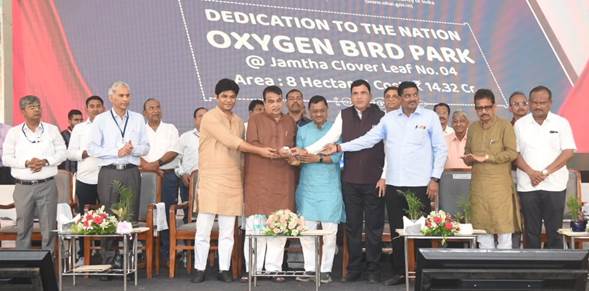Union Minister of Road Transport and Highways Sh. Nitin Gadkari inaugurated Oxygen Bird Park (Amrit Mahotsav Park) along the Nagpur-Hyderabad National Highway-44 in Nagpur, Maharashtra today.

The idea for the park originated from a suggestion by Union Minister Sh. Nitin Gadkari to RO Nagpur to develop a Amrit Mahotsav Park on NHAI land parcel for observing the variety of birds found in this part of Central India as well as recreation of citizens. The vision was to establish a green space provide a safe and natural habitat for a wide variety of bird species. Located in an environment designed to mimic natural ecosystems, the park aims to conserve both local and migratory bird populations. This initiative has been included as an additional work in the broader infrastructural project of developing a four-lane standalone ring road around Nagpur city, with the park located at the Clover Leaf intersection near the Jamtha International Cricket Stadium.

Background
Ecological Features of the Park:
The bird park will feature several distinct areas aimed at conservation and ecological enhancement.
Lotus/Lily Pad Pond: The pond will be home to various lotus and water lilies, providing habitat for water birds and recharging underground aquifers. It will also create a microhabitat with increased humidity. Since the waterbody is deep it has the potential to attract both resident and migrant ducks. The migrant ducks attracted are both diving ducks like pochards and dabbling ducks.
Reed Bed: Located behind the pond, this reed bed will provide an ideal habitat for birds such as waterhens, moorhens, and reed warblers, especially during migration.
Bambusetum: This area will feature native Indian bamboo species. Bamboo will help reduce dust and noise pollution, absorb vehicle emissions, and improve soil quality through its leaf litter.
Plantation Area: Extending beyond the 6-hectare park, this area will include native tree species and shrubs. It will attract wildlife, reduce noise and dust, and enhance air quality by mimicking natural forest conditions.
Palm Plantation: Behind the lake, native Indian palms such as phoenix date palm and toddy palm will be planted. These palms will offer nesting sites for various bird species and small mammals, and support species like hornbills and weaver birds.
Attracting Birds: The park’s flora includes a variety of trees, reeds, aquatic plants, shrubs, and bushes specifically chosen to support local wildlife and enhance biodiversity. Notable species include Neem, Indian Coral Tree, Water Lilies, Lotus, Wild Jasmine, and Karonda.
Visitor Infrastructure
The park offers a range of amenities including a ticket counter, food court, modern toilets, internal pathways, a jogging/cycling track, an amphitheatre with an increased plinth height, watch towers, and cast-iron benches. Landscaping features expanded lawns, green pockets, and an irrigation system. Utilities are well-integrated, including a 200 kVA transformer and additional borewells.
Features of the Oxygen Bird Park
| Feature | Details |
| Food Court | 1 nos Designated area offering a variety of food options |
| Restrooms | Conveniently located restrooms for visitors |
| Walking Paths | Well-designed pathways for leisurely walks |
| Jogging and Cycling Tracks | Dedicated tracks for jogging and cycling |
| Watchtowers | 2 nos Elevated towers for panoramic views of the park |
| Amphitheater Platforms | 1 nos Spaces designed for small gatherings or performances |
| Children’s Play Area | Dedicated space for kids to play and explore |
| Naturally Formed Pond | Scenic pond blending seamlessly with the natural landscape |
| Architectural Entrance Gate | Aesthetically designed entrance gate with striking architecture |
| Landscaped Surroundings | Thoughtfully planned landscaping to enhance the park’s visual appeal |
| Dense Vegetation Development | 2 hectares dedicated to oxygen-generating tree species |
| Water Recharge Pits | 30 pits for water management and groundwater recharge |
Sustainability Initiatives
The park incorporates solar energy through solar panels, which support lighting, water features, and other facilities. This approach reduces reliance on conventional energy sources and promotes environmental sustainability.
Environmental Focus
A core element of the park is its emphasis on sustainability, highlighted by its “Oxygen Park” feature. The planting of fast-growing, oxygen-producing trees aims to combat air pollution and foster a healthier environment. The Social Forestry Division of Nagpur plays a key role in developing and maintaining these green spaces.
The event was attended by Sh.Shyam Kumar Barve, MP, Sh. Tekchand Sawarkar, MLA, Sh.Ashish Jaiswal, MLA, Sh. Vikas Kumbhare, Sh. Sudhakar Kohale and Sh. Anurag Jain, Secretary, MoRTH and Senior Officials of ministry and NHAI.

Comments are closed.